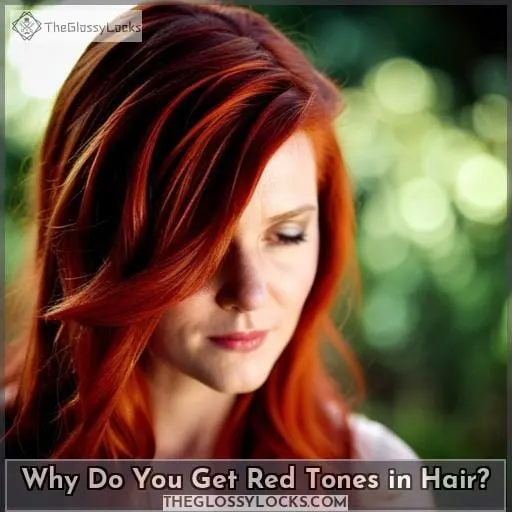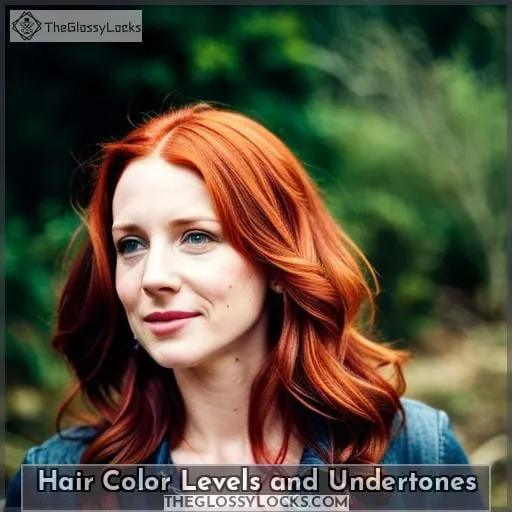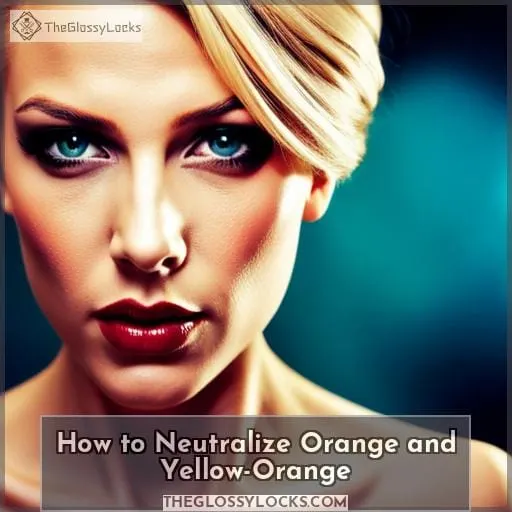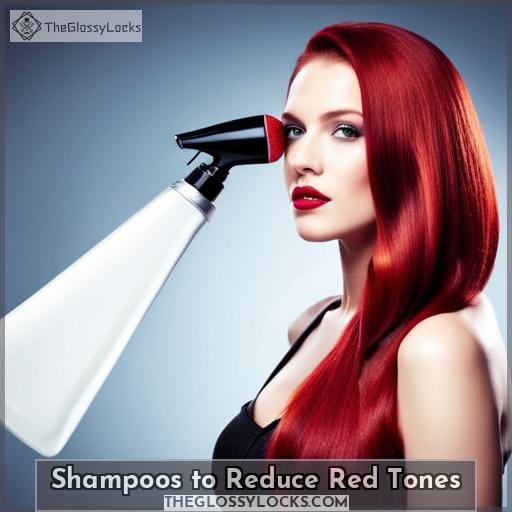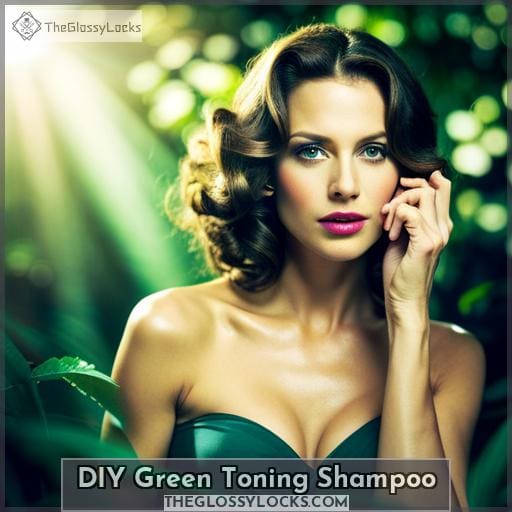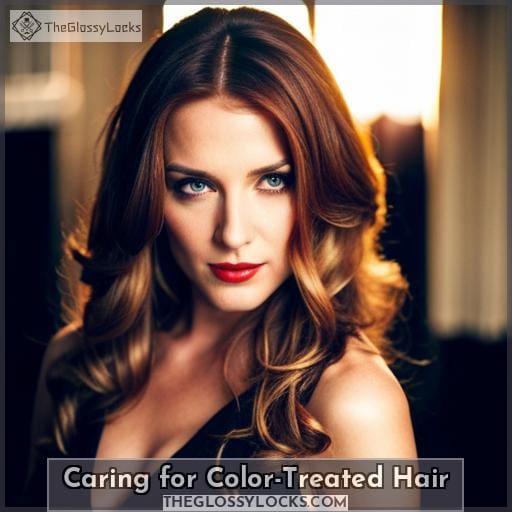This site is supported by our readers. We may earn a commission, at no cost to you, if you purchase through links.
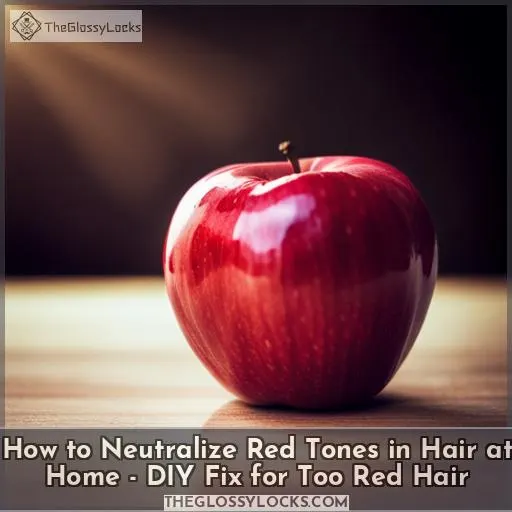
First, fathom why your hair’s so fiery. Lifting causes undertones to surface, making color seem off.
Blue-green shampoos neutralize warmth. Ash washes balance red’s richness. Play chemist and concoct your own toning formula.
Save your strands from shade-shifting snafus. With the right mix, you’ll have neutral nirvana in no time.
Table Of Contents
- Key Takeaways
- Why Do You Get Red Tones in Hair?
- Hair Color Levels and Undertones
- How to Neutralize Red and Reddish-Orange
- How to Neutralize Orange and Yellow-Orange
- Can I Do a Smudge Root?
- Watch a Red Neutralization Transformation
- Shampoos to Reduce Red Tones
- DIY Green Toning Shampoo
- Caring for Color-Treated Hair
- Conclusion
Key Takeaways
- Green and blue-green color additives counteract red and reddish-orange hair tones.
- Do-it-yourself green toning shampoos made with food coloring can help neutralize orange tones.
- Products such as Prell Original Shampoo and Fanola No Orange Shampoo aim to reduce redness.
- Regular use of purple- or blue-toned conditioning products helps maintain color and counteract red tones between salon visits.
Why Do You Get Red Tones in Hair?
You get red tones in your hair when the underlying pigment in your strands shifts from your natural color to red and orange hues. This is from sun exposure, chlorine, hard water minerals, heat styling, and color treatments.
Reddish pigment develops when melanin fades or oxidizes, revealing natural red tones in hair protein. Chemical processes like bleaching, permanent dye, relaxers, and pool chemicals strip away melanin to expose warm undertones.
Heat tools and sun damage degrade melanin over time too. The hair cuticle opens from these stressors, allowing red pigment to leach out.
Toning techniques help rebalance your hair’s undertone by neutralizing or counteracting the excessive red and orange hues. Using opposite colors like green and blue helps cancel unwanted warmth from environmental factors and chemical processing.
With proper maintenance, you can keep your hair color looking vibrant and on tone.
Hair Color Levels and Undertones
Hair color levels and undertones play a crucial role when assessing how to tone unwanted red shades from your locks. To achieve your ideal hue, it’s essential to understand the color spectrum. Most box dyes use a numbering system from 1 (black) to 10 (lightest blonde).
The lower the number, the darker the color. Pay attention to undertones too. Levels 1-3 have warm undertones. Levels 4-6 introduce neutral undertones. Levels 7-10 take on cool undertones. Knowing your starting and target levels and undertones allows customized toning.
For red hair, aim for an ash toner with blue or violet pigments, 1-2 levels lighter than your current shade. This counters ruddy orange undertones. With smart color selection, you can neutralize reds and rock your ideal cool-toned hue.
Through hair color experimentation and undertone insights, you can find the tones that complement and enhance your complexion.
How to Neutralize Red and Reddish-Orange
Using green and blue-green color additives is an effective way to tone down those unwanted red and reddish-orange tones without resorting to bleach.
- Ugly Duckling Professional Ash Grey Additive cancels out orange and brassy tones when mixed into any base color.
- Manic Panic Atomic Turquoise is a direct dye that can be added to conditioner or used alone to counteract red.
- Pravana ChromaSilk Vivids in Green removes warmth from hair when applied full strength or diluted.
- Pulp Riot Blank Canvas neutralizes red pigment for a clean canvas before coloring.
- Adore Creative Image Emerald Green #420 provides vibrant green deposit to effectively neutralize red hair.
Using targeted green and blue-green hair color additives allows you to neutralize and remove unwanted red and reddish-orange tones from the hair’s undertone. Start with small amounts mixed into your favorite toner, gloss, or conditioner for subtle results.
Gradually increase until you achieve the ideal neutralization for your hair without bleach.
How to Neutralize Orange and Yellow-Orange
Take a breather folks – we’ll get through these tricky orange tones together. Now grab that ultraviolet toning shampoo and let’s turn this hair fantabulous!
- Assess your current hair color and level to determine the right toning products.
- Look for toning shampoos and conditioners with blue or violet pigments.
- For darker orange tones, try a demi-permanent color with ash or platinum tones.
- Rinse with cool water and limit heat styling to maximize toning results.
- Be patient – it may take a few applications to neutralize orange or yellow undertones.
With some trial and error, you can get your hair to a beautiful, natural-looking shade.
Can I Do a Smudge Root?
You’ll accentuate ash-toned results with clever smudge roots.
| Tip | Description |
|---|---|
| Use a lighter mix near the roots | Creates a shadow effect for depth |
| Blend the smudge into natural hair | No harsh lines between shades |
| Focus most color mid-length | Avoid over-saturating the ends |
Smudge roots add dimension to your ash blonde or brunette by mimicking regrowth. Mix an ash toner or dye shade lighter than your target color. Paint it thinly onto the roots and feather it into your natural hair using a tinting brush.
Concentrate the color 1-2 inches from the scalp and taper it through the mid-lengths for a soft, lived-in look. Refresh every 4-6 weeks to maintain your regrowth illusion. With careful blending and lighter mixing, smudge roots boost the cool tones in your hair.
Watch a Red Neutralization Transformation
See Sally Madison, National Color Trainer, demonstrate Elona’s stunning hair transformation using an ash gray additive and green to beautifully neutralize red tones.
- Observe how Sally sections Elona’s hair and evaluates undertones to determine toning needs
- Note mixing ratios when preparing toners to achieve desired shade
- Watch application techniques ensuring thorough coverage for even results
- See how quickly toner corrects unwanted red-orange tones
- Be inspired by the impressive before and after reveal of Elona’s hair
Through her expertise in formulation chemistry and hands-on color correction experience, Sally skillfully neutralizes Elona’s unwanted red tones and achieves a beautiful, natural brunette result. This video provides an inside look at professional techniques using bespoke toners to target specific undertones for hair color correction.
Sally’s step-by-step guidance equips you with knowledge to evaluate your hair needs and achieve customized, stunning hair transformations at home.
Shampoos to Reduce Red Tones
Let’s start removing unwanted red tones with Prell Original Shampoo. The classic formula will help fade red hues as you cleanse without drying out your hair. Next, try Fanola No Orange Shampoo, a blue-pigmented formula that counteracts copper and red tones for consistent, brighter color results.
Prell Shampoo
You’ll find vintage Prell shampoo cleanses hair and leaves it looking shiny. This rich, thick formula is gentle yet effective for all hair types. Customers have used Prell for over 70 years thanks to its brightening results and clean scent.
While hard to find in stores nowadays, many still love this classic cleanser that removes oils and chlorine without stripping color.
Fanola No Orange
Try Fanola’s No Orange shampoo to neutralize those pesky copper and red highlights in your locks. This anti-orange toning shampoo contains blue pigment to tone down unwanted warm tones in colored medium to dark hair.
Toning hair after coloring helps promote a more vibrant and even result. Using it once or twice per week reduces orangey highlights while restoring moisture and shine. Toning helps maintain your color’s integrity between salon visits. Support your stylist’s hard work and money spent by keeping color fresh with at-home toning products.
DIY Green Toning Shampoo
Create your own green toning shampoo by gradually adding drops of McCormick’s vibrant green food coloring to your regular shampoo until you achieve the desired tone. Start with just a few drops to test the intensity. Green toning helps neutralize brassy red and orange tones in hair for a more natural, ashy blonde or brunette shade.
- Monitor color deposit
- Add dye gradually
- Store in a sealed container
- Apply to dry hair
Homemade green toning shampoo allows you to customize the pigment level. Adding green dye to your regular shampoo helps tone down unwanted warm tones between salon visits.
Caring for Color-Treated Hair
You invested in color, now it’s time to invest in care. To protect red hair color and maintain vibrancy, apply a protein mask weekly and use a hydrating oil like jojoba before shampooing.
Protein Masks
tis a treat for the tresses when nourishing masks deeply penetrate every follicle after a dye job to restore strength in a jiffy!
After lightening hair, protein masks are vital for rebuilding bonds and preventing breakage.
| Product | Key Benefits |
|---|---|
| ApHogee Two-Step Protein Treatment | Repairs severe damage; contains keratin |
| Neutral Protein Filler by Redken | Pre-color fortifying treatment |
| Shea Moisture Manuka Honey & Yogurt Hydrate + Repair Protein Power Treatment | Intense moisture; reduces frizz |
| Verb Ghost Oil | Lightweight; reduces flyaways |
| DIY Egg Yolk Mask | Natural protein; simple recipe |
Mix up some egg yolk, olive oil, and honey for an easy DIY treatment. Apply any mask liberally on shampooed hair, and leave on for 5-10 minutes before rinsing for strong, soft strands.
Hydrating Oils
Apply organic jojoba oil before shampooing for added hydration and frizz control. Known for closely mimicking the skin’s natural oils, jojoba is readily absorbed to moisturize and soften hair. Non-greasy and lightweight, it helps repair damage and seal in color vibrancy. Dilute with other carrier oils as desired.
- Avocado oil penetrates to nourish hair from within.
- Argan oil tames frizz and flyaways for sleeker styling.
- Olive oil packs vitamins and fatty acids to improve shine.
- Grapeseed oil is lightweight and won’t weigh hair down.
- Coconut oil protects against hygral fatigue and UV damage.
Conclusion
As you can see, reversing overly red hair is possible when armed with the right knowledge. By understanding hair’s undertones and utilizing opposite colors, you can neutralize and tone problematic red tones for softer, more natural-looking hair.
With a smart combination of clarifying shampoos, DIY green toners, and nourishing treatments, you’ll be on your way to fixing too-red hair and keeping your color vibrant and balanced. Take control of your color results at home through these simple, effective steps for neutralizing red tones in hair.

